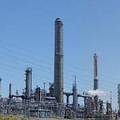 美國環保局(EPA)23日表示,在最近的分析報告中發現,從煉油廠所排放的空氣有毒物質,對於人類健康和環境的威脅很低,沒有進一步管制的必要。
美國環保局(EPA)23日表示,在最近的分析報告中發現,從煉油廠所排放的空氣有毒物質,對於人類健康和環境的威脅很低,沒有進一步管制的必要。
美國環保局是以空氣清淨法案的部分規定,對煉油廠所排放的空氣有毒物質進行分析,並以1995年「最大可達控制技術」(maximum achievable control. technology, MACT)中要求工業設備必須減少排放有毒空氣污染物的標準,來檢測煉油廠潛在的危險性。
在此分析結果的基礎下,美國環保局提出了2個方案,用以控制煉油廠的有毒空氣污染物排放量。
第一個方案為,維持原案、不採取額外措施,因為煉油廠可能造成的風險很低,而且尚在可接受的範圍內。
第二個方案為,針對特定的貯存槽或廢水處理單位,必須削減更多有害空氣物質的排放。
A recent analysis by the U.S. Environmental Protection Agency, EPA, on the risks from air toxics emitted from petroleum refineries found that the risks to human health and the environment are low enough that no further controls are warranted, the agency said Thursday.
The EPA analyzed the petroleum refinery emissions as part of a Clean Air Act requirement that the agency examine potential risks remaining after implementation of 1995 standards known as maximum achievable control and technology, MACT, that require industrial facilities to reduce emissions of toxic air pollutants.
Based on the results of the analysis, EPA is proposing two options for controlling air toxics emissions from refineries.
The first option requires no additional emissions reductions because the risks are "acceptably low."
As a second option, the EPA is proposing requiring additional emissions reductions for certain storage vessels wastewater treatment units.
全文及圖片詳見ENS



